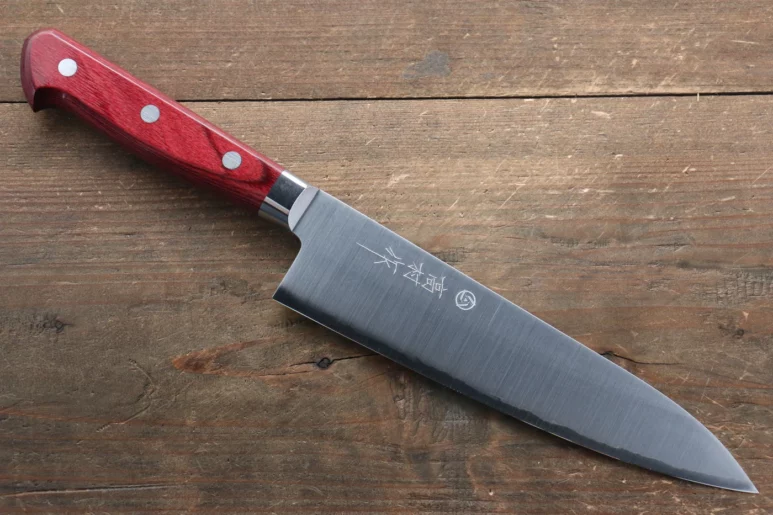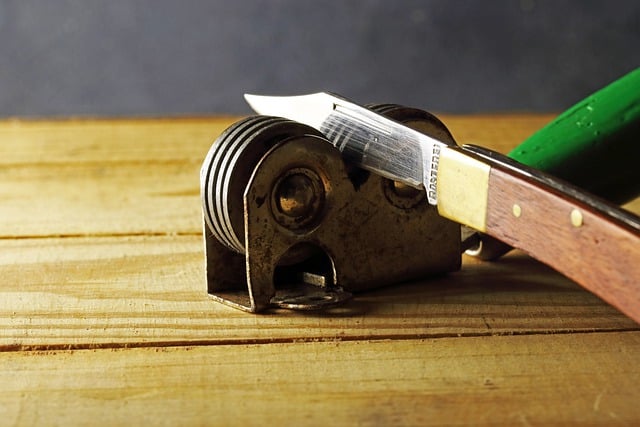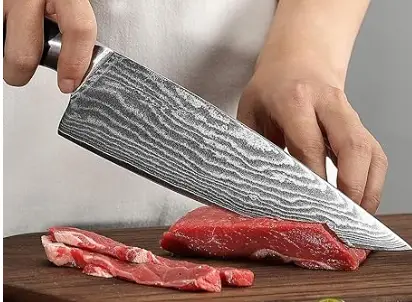What is Super Gold 2 steel?
However, you can still purchase it from other Japanese steelmakers. It is also referred to as R2 and SGPS with the letters PS noting that it is powder steel.
Is SG2 the same as R2?
SG2 steel is mostly laminated when in use by other knife makers like Fallkniven in 3G steel. The laminate layers protect the core SG2 from scratching and add an extra layer of corrosion resistance.
SG2 steel is specially formulated for knife making, and thus it is used in various types of knives, including chef and kitchen knives. knives forged from SG2/R2 steel with a good heat treatment process will perform better than stamped knives from SG2/R2 steel.
SG2 Steel Composition
- Carbon C 1.45%: Increases edge retention, hardness, and tensile strength. It also improves steel resistance to wear, abrasion, and corrosion.
- Chromium Cr 16.00%: Increases hardness, tensile strength, and toughness of the blade by forming chromium carbide. The higher than 13% Cr is what makes R2 “stainless”
- Molybdenum Mo 3.30%: It improves machinability and hardening property.
- Vanadium V 2.20%: Increase wear resistance and toughness, it also improves corrosion resistance.
- Manganese Mn 0.40%: Increases Hardness, and tensile strength but decreases ductility.
- Phosphorus P 0.03%: Improves machinability and hardness but is normally regarded as an impurity affecting performance.
- Sulphur S 0.03% Improves machinability but is normally regarded as an impurity affecting performance.
- Silicon Si 0.50% Improves strength of steel
Properties of SG2 steel
SG2 Steel Hardness
SG2 steel has a hardness of 64 HRC as per the Rockwell hardness scale. This is exceptionally high hardness, and it results from the high carbon content and the powder metallurgy production process. Its hardness greatly influences the critical features of SG2 stainless steel like edge retention and wear resistance.
SG2 Steel Toughness
SG2 is not very tough steel, its toughness is just okay, lower than the budget Chinese 8Cr13MoV stainless steel but slightly better than AISI 440C. The toughness of steel tends to drop when hardness is high.
SG2 level of toughness can handle daily applications, depending on the impact and force from the application, it is more likely to bend and chip, but it does not break easily.
SG2 Steel Wear Resistance
Because of its high hardness, SG2 offers excellent wear resistance. It does not quickly wear from frequent use and sharpening; therefore, SG2 knives will serve you for a very long time. Because of the high wear resistance of SG2 steel. SG2 steel knives will do well cutting through abrasive materials.
SG2 Steel Edge Retention
Edge retention defines how long steel takes to get blunt, which is directly influenced by hardness. Being very hard steel, SG2 offers excellent edge retention. This means that it maintains a sharp edge for a long time, even with frequent use.
You do not have to sharpen SG2 blades after every use which makes them easy to maintain. SG2 steel edge retention is better than most knife steels. Its edge retention is at par with other powder metallurgy-produced steels like S35VN and Magnacut.
SG2 Steel Corrosion Resistance
SG2 steel is stainless steel, it contains high chromium content and molybdenum in its composition, SG2 steel can fight rusting and corrosion better than other high-end stainless steel.
SG2 knives can be used in high humidity areas, kitchens, and in salty water environments for fishing. SG2 corrosion resistance though high still does not match up to the likes of LC200N, Vanax, and S110V.
Although SG2 steel can fight corrosion, it can rust if exposed to highly corrosive environments. For instance, you cannot leave the knives in water overnight and expect them to remain rust-free.
This calls for proper care and maintenance, which is as simple as cleaning and drying the knives immediately after use. Also, oil the knives and remove them from their sheaths if you plan to store them for an extended period.
Ease of Sharpening SG2 steel
Unexpected to many knife users, SG2 is not hard to sharpen despite the excellent hardness and wear resistance, thanks to its chemical composition SG2 blades achieve a sharp edge very fast because of their fine microstructure.
SG2 vs other steels
SG2 Steel vs VG10
The main difference between SG2 steel and VG10 steel is that SG2 steel is a powder metallurgy-produced steel while VG10 is conventionally produced. SG2 blade steel beats VG10 blade steel slightly in edge retention and ease of sharpening.
The increased performance of SG2 steel in edge retention and ease of sharpening can be attributed to its fine microstructure obtained through the powder metallurgy production process. SG2 alloy also contains fewer elements compared to VG10 alloy but still offers the same toughness and hardness, another added benefit of the powder metallurgy process.
Both SG2 and VG10 are products of the Japanese Takefu steel company, with VG10 being older. Apart from edge retention and ease of sharpening, they offer the same toughness and corrosion resistance level.
SG2 Steel vs S30V
S30V steel and SG2 steel share the same powder metallurgy production process. They also contain reduced chromium elements in combination with molybdenum to increase their corrosion resistance.
The main difference between S30V and SG2 is that S30V has slightly more Vanadium elements in its alloy composition. The increased Vanadium elements lead to a higher percentage of vanadium carbides, which in turn improves the edge retention and wear resistance of S30V over SG2 steel.
In other performance aspects, SG2 and S30V offer the same level of toughness and corrosion resistance, but it is much easier to sharpen SG2 knives due to the reduced wear resistance.
SG2 Steel vs Blue steel
The main difference between SG2 and Blue steel is that SG2 is stainless steel while Blue steel is non-stainless steel hence SG2 offers better corrosion and rust resistance compared to blue steel. Blue steels come in three variants; Blue steel #1, Blue steel #2 and Blue Super all of which prioritize hardness and edge retention over corrosion resistance
The edge retention of these blue steels increases with the hardness. Blue Super at 64HRC offers the best edge retention in the bunch. It is mainly used to forge high-end Japanese kitchen knives and is very expensive.
In terms of toughness, SG2 offers better toughness than any blue steel. SG2 PM production process allows it to attain fine microstructure which improves its toughness and ease of sharpening.



